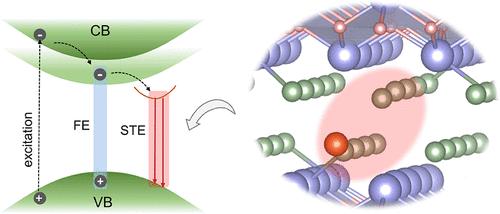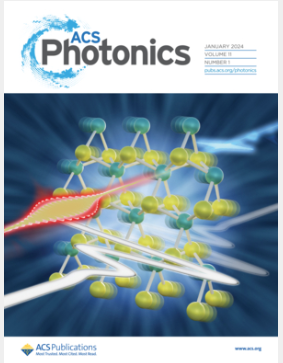边碘掺杂激活氧化卤化铋中本征自困激子发射
IF 6.5
1区 物理与天体物理
Q1 MATERIALS SCIENCE, MULTIDISCIPLINARY
引用次数: 0
摘要
氧化卤化铋(BiOX, X = F, Cl, Br, I)由于其独特的层状结构和光催化性能而在光电子学、辐射探测器和光催化领域受到了广泛的关注。然而,对光激发态特性的难以理解,特别是先前与BiOX中缺陷诱导态相关的宽亚带隙发射,阻碍了相关的光诱导物种调节。本文以BiOBr为例,说明了亚带隙发射是由自俘获激子(STEs)的辐射衰变引起的。边缘碘掺杂可以有效激活这一辐射过程。光谱分析和理论计算证实了激子-声子相互作用的增强,对称破缺解释了碘掺入BiOBr中ste -发射激活。此外,通过调整卤化物组成,BiOClxBr1-x中STEs的能量可以很容易地从2.5 eV调节到2.16 eV,有望实现光致发光和能量转移介导的光催化小分子活化等光激发应用。这项工作揭示了BiOX的内在STE状态,并为相关光激发态特性的调控提供了新的见解。本文章由计算机程序翻译,如有差异,请以英文原文为准。

Activating Intrinsic Self-Trapped Exciton Emission in Bismuth Oxyhalides by Edge Iodine Doping
Bismuth oxyhalides (BiOX, X = F, Cl, Br, I) have gained great attention in optoelectronics, radiation detectors, and photocatalysis due to their unique layered structure and electronic properties. However, the elusive understanding of photoexcited-state properties, particularly the broad sub-bandgap emission previously associated with defect-induced states in BiOX, impedes the relevant photoinduced-species regulation. Herein, by taking BiOBr as an example, we elucidate the sub-bandgap emission to originate from the radiative decay of self-trapped excitons (STEs). Such a radiative process could be effectively activated by edge iodine doping. Spectroscopic analyses and theoretical calculations verify enhanced exciton–phonon interaction, and symmetry breaking account for the STE-emission activation in BiOBr with iodine incorporation. Besides, by tuning halide composition, the energies of STEs in BiOClxBr1–x could be facilely regulated from 2.5 to 2.16 eV, promisingly enabling photoexcited applications such as photoluminescence and energy-transfer-mediated photocatalytic small molecule activation. This work uncovers the intrinsic STE states in BiOX and provides new insights into the regulation of the involved photoexcited-state properties.
求助全文
通过发布文献求助,成功后即可免费获取论文全文。
去求助
来源期刊

ACS Photonics
NANOSCIENCE & NANOTECHNOLOGY-MATERIALS SCIENCE, MULTIDISCIPLINARY
CiteScore
11.90
自引率
5.70%
发文量
438
审稿时长
2.3 months
期刊介绍:
Published as soon as accepted and summarized in monthly issues, ACS Photonics will publish Research Articles, Letters, Perspectives, and Reviews, to encompass the full scope of published research in this field.
 求助内容:
求助内容: 应助结果提醒方式:
应助结果提醒方式:


